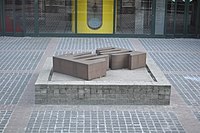Carel Visser

Carel Nicolaas Visser (3 May 1928 – 1 March 2015) was a Dutch sculptor. He is considered an important representative of Dutch abstract-minimalist constructivism in sculpture.
Life and work
Visser was born on 3 May 1928 in Papendrecht.[1] From 1948 until 1949 Visser studied architecture at the Technical University in Delft and subsequently from 1949 until 1951 sculpture at the Royal Academy of Arts, The Hague. After study in England and France, he settled as an independent artist in 1952 in Amsterdam.

In his early career Visser created originally styled iron bird sculptures and had his first solo exhibition in 1954 at Galerie Martinet in Amsterdam. In 1957, when his artistic style became more abstract, a new period began in which he made several trips: a study trip to Italy (Sardinia) on a scholarship from the Italian government in 1957; a stay as a visiting professor at Washington University in St. Louis in 1962; and a study trip to Mexico on a Dutch government scholarship in 1965. Visser was a lecturer at the Royal Academy in The Hague from 1958 to 1962.
In 1968 Visser's work was exhibited at Documenta 4 in Kassel, Germany and in the same year he represented the Netherlands in the Venice Biennial, where he was awarded the David E. Bright sculpture prize.[2][3] In the same year a documentary film about his work was made by Jonne Severijn. In 1981 Visser settled in Rijswijk (Gelderland). From 1966 to 1998 he was Professor at the Ateliers '63 in Haarlem. Visser was recipient of the 1992 Dr A. H. Heineken Prize for Art.[4] In 2004 he received the Wilhelmina-ring for his lifetime achievements.
Visser died on 1 March 2015 in Le Fousseret, France, at the age of 86.[1]
Work
Carel Visser is seen as one of the most important constructivist sculptors of the Netherlands. His later work is characterized by the assembly of a variety of materials, such as tires, oil drums, car windows, leather, sheepskin, eggs and so on. He made organized connections, a kind of assemblages, with this so-called great and sometimes small objets trouvés (found objects). Some of his work has been compared to a musical composition in which repetition and variation play an important role.
Around 1960, Visser was focussed on massive closed cube of iron and "slack" cube wire. Visser, among other things, was inspired by nature (plants and animals) which also explains his use of natural materials such as wood, wool, sand, feathers, bones, rope and leather.
His works from the period 1975-1985 could be called environments, as opposed to the more sculptural work as the dying horse (about 1949).
Gallery
1950s
-
 Opspuitend water, Leerdam, 1954
Opspuitend water, Leerdam, 1954 -
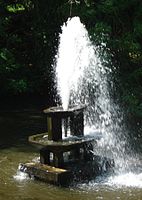 Fotein, Leerdam 1954
Fotein, Leerdam 1954
1960s
-
 De Grote Vier (1962), Amersfoort
De Grote Vier (1962), Amersfoort -
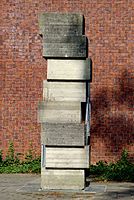 Stapeling (1965), Stadskanaal
Stapeling (1965), Stadskanaal -
 Salami (1966), Delft
Salami (1966), Delft - Kubus en zijn stapeling (1967), Otterlo
- Grote Auschwitz (1967), Otterlo
-
 Speelplastiek (1968), Oegstgeest
Speelplastiek (1968), Oegstgeest -
 When the saints go marching in (1968), The Hague
When the saints go marching in (1968), The Hague -
 De Poort (1969), Groningen
De Poort (1969), Groningen
1970s
- No title (1975), Utrecht
1980s
-
 Vier Wiggen (1980), Groningen
Vier Wiggen (1980), Groningen - Vijfstromenland (1981), Amsterdam
-
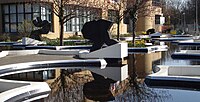 Zes sculpturen (1985), Den Haag
Zes sculpturen (1985), Den Haag - Untitled (1988), sculpturepark KMM
1990s
-
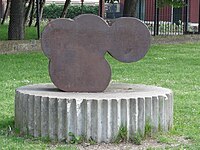 Untitled (1991), Nijmegen
Untitled (1991), Nijmegen -
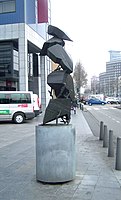 Sculpture (no title) (1994) at the Spui in The Hague
Sculpture (no title) (1994) at the Spui in The Hague - Vogels (1998), Eindhoven
- Pleinbeeld (1998)
New millennium
-
 Moeder en kind (2000), Rotterdam
Moeder en kind (2000), Rotterdam -
 Meer (2004), Apeldoorn
Meer (2004), Apeldoorn
References
- ^ a b "Carel Visser: Sculptor hailed as a master of minimalism who turned metal and concrete into elegant and powerful forms". The Independent. 5 March 2015. Archived from the original on 17 November 2019.
- ^ "Carel Visser (1928)". Archived from the original on 2015-04-02. Retrieved 2015-03-13.
- ^ "Carel Visser 1928–2015". Archived from the original on 2019-03-30. Retrieved 2015-03-13.
- ^ "Carel Visser (1928), the Netherlands". Royal Netherlands Academy of Arts and Sciences. Archived from the original on 25 May 2019.
External links
 Media related to Carel Visser at Wikimedia Commons
Media related to Carel Visser at Wikimedia Commons
- v
- t
- e
- Chargaff (1964)
- Brachet (1967)
- Chance (1970)
- De Duve (1973)
- Van Deenen (1976)
- Klug (1979)
- Weissmann (1982)
- Julesz & Reichardt (1985)
- Cech (1988)
- Leder (1990)
- Borst (1992)
- Berridge (1994)
- Nurse (1996)
- Pawson (1998)
- Rothman (2000)
- Tsien (2002)
- Fire (2004)
- Jeffreys (2006)
- Szostak (2008)
- Hartl (2010)
- De Lange (2012)
- Dobson (2014)
- Doudna (2016)
- Zhuang (2018)
- Stillman (2020)
- Verhoef (1988)
- Bot (1990)
- C. Visser (1992)
- Röling (1994)
- Martens (1996)
- Van de Pavert (1998)
- Geelen (2000)
- Mik (2002)
- Van Golden (2004)
- Koelewijn (2006)
- B. Visser (2008)
- Manders (2010)
- Struycken (2012)
- Van Oldenborgh (2014)
- Dröge Wendel (2016)
- Van Lieshout (2018)
- Blom (2020)












